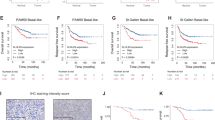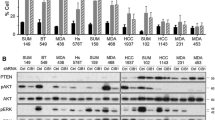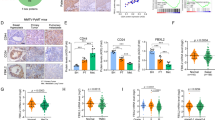Abstract
LIN9 functions to regulate cell mitotic process. Dysregulation of LIN9 expression is associated with development of human cancers. In this study we assessed the association of LIN9 expression with paclitaxel resistance and clarified the underlying mechanisms for the first time. LIN9 expression in breast cancer tissues was retrieved from publicly available online databases and statistically analyzed. Human TNBC cell lines MDA-MB-231 and MDA-MB-468 and their corresponding paclitaxel-resistant sublines 231PTX and 468PTX were used to assess the expression of LIN9 by qRT-PCR and Western blot, cell growth by cell counting, cell viability by MTS assay, and cell apoptosis by flow cytometry. The data showed that high LIN9 expression in breast cancer patients receiving chemotherapy was related to poor overall survival (OS). LIN9 expression was upregulated in paclitaxel-resistant TNBC cells compared to their parental cells. Knockdown of LIN9 or treatment of paclitaxel-resistant TNBC cells with a bromo- and extra-terminal domain inhibitor (BETi) JQ1 which also decreased LIN9 expression enhanced the sensitivity of paclitaxel-resistant TNBC cells to paclitaxel. Mechanistically, decreased LIN9 in resistant cell lines reduced tumor cell viability, promoted multinucleated cells formation and induced tumor cell apoptosis, potentially by directly regulating microtubule-binding protein CCSAP. In conclusion, high LIN9 expression contributed to poor clinical outcomes and paclitaxel resistance in TNBC and BETi, targeting LIN9 expression, could be a reversible drug for PTX-resistant TNBC patients.
Similar content being viewed by others
References
Amorim, S., Stathis, A., Gleeson, M., Iyengar, S., Magarotto, V., Leleu, X., Morschhauser, F., Karlin, L., Broussais, F., Rezai, K., et al. (2016). Bromodomain inhibitor OTX015 in patients with lymphoma or multiple myeloma: a dose-escalation, open-label, pharmacokinetic, phase 1 study. Lancet Haematol 3, e196–e204.
Asangani, I.A., Dommeti, V.L., Wang, X., Malik, R., Cieslik, M., Yang, R., Escara-Wilke, J., Wilder-Romans, K., Dhanireddy, S., Engelke, C., et al. (2014). Therapeutic targeting of BET bromodomain proteins in castration-resistant prostate cancer. Nature 510, 278–282.
Begley, U., Sosa, M.S., Avivar-Valderas, A., Patil, A., Endres, L., Estrada, Y., Chan, C.T.Y., Su, D., Dedon, P.C., Aguirre-Ghiso, J.A., et al. (2013). A human tRNA methyltransferase 9-like protein prevents tumour growth by regulating LIN9 and HIF1-α. EMBO Mol Med 5, 366–383.
Berthon, C., Raffoux, E., Thomas, X., Vey, N., Gomez-Roca, C., Yee, K., Taussig, D.C., Rezai, K., Roumier, C., Herait, P., et al. (2016). Bromodomain inhibitor OTX015 in patients with acute leukaemia: a dose-escalation, phase 1 study. Lancet Haematol 3, e186–e195.
Bian, M.L., Fu, J.Y., Yan, Y., Chen, Q., Yang, C., Shi, Q.H., Jiang, Q., and Zhang, C.M. (2010). Short exposure to paclitaxel induces multipolar spindle formation and aneuploidy through promotion of acentrosomal pole assembly. Sci China Life Sci 53, 1322–1329.
Calvisi, D.F., Simile, M.M., Ladu, S., Frau, M., Evert, M., Tomasi, M.L., Demartis, M.I., Daino, L., Seddaiu, M.A., Brozzetti, S., et al. (2011). Activation of v-Myb avian myeloblastosis viral oncogene homolog-like2 (MYBL2)-LIN9 complex contributes to human hepatocarcinogenesis and identifies a subset of hepatocellular carcinoma with mutant p53. Hepatology 53, 1226–1236.
Casazza, A.M., and Fairchild, C.R. (1996). Paclitaxel (Taxol): mechanisms of resistance. Cancer Treat Res 87, 149–171.
Cortes, J., O’Shaughnessy, J., Loesch, D., Blum, J.L., Vahdat, L.T., Petrakova, K., Chollet, P., Manikas, A., Diéras, V., Delozier, T., et al. (2011). Eribulin monotherapy versus treatment of physician’s choice in patients with metastatic breast cancer (EMBRACE): a phase 3 open-label randomised study. Lancet 377, 914–923.
de Ruijter, T.C., Veeck, J., de Hoon, J.P.J., van Engeland, M., and Tjan-Heijnen, V.C. (2011). Characteristics of triple-negative breast cancer. J Cancer Res Clin Oncol 137, 183–192.
DeCaprio, J.A. (2014). Human papillomavirus type 16 E7 perturbs DREAM to promote cellular proliferation and mitotic gene expression. Oncogene 33, 4036–4038.
Eckerdt, F., Perez-Neut, M., and Colamonici, O.R. (2014). LIN-9 phosphorylation on threonine-96 is required for transcriptional activation of LIN-9 target genes and promotes cell cycle progression. PLoS ONE 9, e87620.
Filippakopoulos, P., Qi, J., Picaud, S., Shen, Y., Smith, W.B., Fedorov, O., Morse, E.M., Keates, T., Hickman, T.T., Felletar, I., et al. (2010). Selective inhibition of BET bromodomains. Nature 468, 1067–1073.
Gagrica, S., Hauser, S., Kolfschoten, I., Osterloh, L., Agami, R., and Gaubatz, S. (2004). Inhibition of oncogenic transformation by mammalian Lin-9, a pRB-associated protein. EMBO J 23, 4627–4638.
Gayle, S.S., Sahni, J.M., and Keri, R.A. (2017). BETi induction of mitotic catastrophe: towing the LIN9. Oncoscience 4, 128–130.
Goldspiel, B.R. (1997). Clinical overview of the taxanes. Pharmacotherapy 17, 110S–125S.
Hauser, S., Ulrich, T., Wurster, S., Schmitt, K., Reichert, N., and Gaubatz, S. (2012). Loss of LIN9, a member of the DREAM complex, cooperates with SV40 large Tantigen to induce genomic instability and anchorage-independent growth. Oncogene 31, 1859–1868.
Kassam, F., Enright, K., Dent, R., Dranitsaris, G., Myers, J., Flynn, C., Fralick, M., Kumar, R., and Clemons, M. (2009). Survival outcomes for patients with metastatic triple-negative breast cancer: implications for clinical practice and trial design. Clin Breast Cancer 9, 29–33.
Kleinschmidt, M.A., Wagner, T.U., Liedtke, D., Spahr, S., Samans, B., and Gaubatz, S. (2009). lin9 is required for mitosis and cell survival during early zebrafish development. J Biol Chem 284, 13119–13127.
McGrogan, B.T., Gilmartin, B., Carney, D.N., and McCann, A. (2008). Taxanes, microtubules and chemoresistant breast cancer. Biochim Biophys Acta Rev Cancer 1785, 96–132.
Nurse, P. (1990). Universal control mechanism regulating onset of M-phase. Nature 344, 503–508.
Osterloh, L., von Eyss, B., Schmit, F., Rein, L., Hübner, D., Samans, B., Hauser, S., and Gaubatz, S. (2007). The human synMuv-like protein LIN-9 is required for transcription of G2/M genes and for entry into mitosis. EMBO J 26, 144–157.
Paridaens, R., Biganzoli, L., Bruning, P., Klijn, J.G.M., Gamucci, T., Houston, S., Coleman, R., Schachter, J., Van Vreckem, A., Sylvester, R., et al. (2000). Paclitaxel versus doxorubicin as first-line single-agent chemotherapy for metastatic breast cancer: a European Organization for Research and Treatment of Cancer Randomized Study with cross-over. J Clin Oncol 18, 724.
Pilkinton, M., Sandoval, R., and Colamonici, O.R. (2007). Mammalian Mip/LIN-9 interacts with either the p107, p130/E2F4 repressor complex or B-Myb in a cell cycle-phase-dependent context distinct from the Drosophila dREAM complex. Oncogene 26, 7535–7543.
Rastelli, F., Biancanelli, S., Falzetta, A., Martignetti, A., Casi, C., Bascioni, R., Giustini, L., and Crispino, S. (2010). Triple-negative breast cancer: current state of the art. Tumori J 96, 875–888.
Reichert, N., Wurster, S., Ulrich, T., Schmitt, K., Hauser, S., Probst, L., Götz, R., Ceteci, F., Moll, R., Rapp, U., et al. (2010). Lin9, a subunit of the mammalian DREAM complex, is essential for embryonic development, for survival of adult mice, and for tumor suppression. Mol Cell Biol 30, 2896–2908.
Romond, E.H., Perez, E.A., Bryant, J., Suman, V.J., Geyer, C.E. Jr, Davidson, N.E., Tan-Chiu, E., Martino, S., Paik, S., Kaufman, P.A., et al. (2005). Trastuzumab plus adjuvant chemotherapy for operable HER2-positive breast cancer. N Engl J Med 353, 1673–1684.
Sahni, J.M., Gayle, S.S., Webb, B.M., Weber-Bonk, K.L., Seachrist, D.D., Singh, S., Sizemore, S.T., Restrepo, N.A., Bebek, G., Scacheri, P.C., et al. (2017). Mitotic vulnerability in triple-negative breast cancer associated with LIN9 is targetable with BET inhibitors. Cancer Res 77, 5395–5408.
Schiff, P.B., Fant, J., and Horwitz, S.B. (1979). Promotion of microtubule assembly in vitro by taxol. Nature 277, 665–667.
Schmit, F., Korenjak, M., Mannefeld, M., Schmitt, K., Franke, C., von Eyss, B., Gagrica, S., Hänel, F., Brehm, A., and Gaubatz, S. (2007). LINC, a human complex that is related to pRB-containing complexes in invertebrates regulates the expression of G2/M genes. Cell Cycle 6, 1903–1913.
Shao, T.F., Zheng, Y.T., Zhao, B., Li, T., Cheng, K.G., and Cai, W.M. (2014). Recombinant expression of different mutant K-ras gene in pancreatic cancer Bxpc-3 cells and its effects on chemotherapy sensitivity. Sci China Life Sci 57, 1011–1017.
Shi, H., Bevier, M., Johansson, R., Enquist-Olsson, K., Henriksson, R., Hemminki, K., Lenner, P., and Försti, A. (2012). Prognostic impact of polymorphisms in the MYBL2 interacting genes in breast cancer. Breast Cancer Res Treat 131, 1039–1047.
Sotiriou, C., and Pusztai, L. (2009). Gene-expression signatures in breast cancer. N Engl J Med 360, 790–800.
Stathis, A., Zucca, E., Bekradda, M., Gomez-Roca, C., Delord, J.P., de La Motte Rouge, T., Uro-Coste, E., de Braud, F., Pelosi, G., and French, C. A. (2016). Clinical response of carcinomas harboring the BRD4-NUT oncoprotein to the targeted bromodomain inhibitor OTX015/MK-8628. Cancer Discov 6, 492–500.
Sudo, T., Nitta, M., Saya, H., and Ueno, N.T. (2004). Dependence of paclitaxel sensitivity on a functional spindle assembly checkpoint. Cancer Res 64, 2502–2508.
Tian, S., Roepman, P., Van–t Veer, L.J., Bernards, R., de Snoo, F., and Glas, A.M. (2010). Biological functions of the genes in the mammaprint breast cancer profile reflect the hallmarks of cancer. Biomark Insights 5, BMI.S6184.
Torre, L.A., Bray, F., Siegel, R.L., Ferlay, J., Lortet-Tieulent, J., and Jemal, A. (2015). Global cancer statistics, 2012. CA Cancer J Clin 65, 87–108.
Wang, T.H., Wang, H.S., and Soong, Y.K. (2000). Paclitaxel-induced cell death. Cancer 88, 2619–2628.
Wiseman, E.F., Chen, X., Han, N., Webber, A., Ji, Z., Sharrocks, A.D., and Ang, Y.S. (2015). Deregulation of the FOXM1 target gene network and its coregulatory partners in oesophageal adenocarcinoma. Mol Cancer 14, 69.
Xiang, J., Wu, B., Zhou, Z., Hu, S., Piao, Y., Zhou, Q., Wang, G., Tang, J., Liu, X., and Shen, Y. (2018). Synthesis and evaluation of a paclitaxel-binding polymeric micelle for efficient breast cancer therapy. Sci China Life Sci 61, 436–447.
Ying, X., Huang, A., Xing, Y., Lan, L., Yi, Z., and He, P. (2017). Lycorine inhibits breast cancer growth and metastasis via inducing apoptosis and blocking Src/FAK-involved pathway. Sci China Life Sci 60, 417–428.
Acknowledgements
This work was supported by the National Natural Science Foundation of China (81672622, 81702630) and China Post-doctoral Science Foundation (2018M643331).
Author information
Authors and Affiliations
Corresponding authors
Ethics declarations
Compliance and ethics The author(s) declare that they have no conflict of interest.
Rights and permissions
About this article
Cite this article
Lai, H., Wang, R., Li, S. et al. LIN9 confers paclitaxel resistance in triple negative breast cancer cells by upregulating CCSAP. Sci. China Life Sci. 63, 419–428 (2020). https://doi.org/10.1007/s11427-019-9581-8
Received:
Accepted:
Published:
Issue Date:
DOI: https://doi.org/10.1007/s11427-019-9581-8




